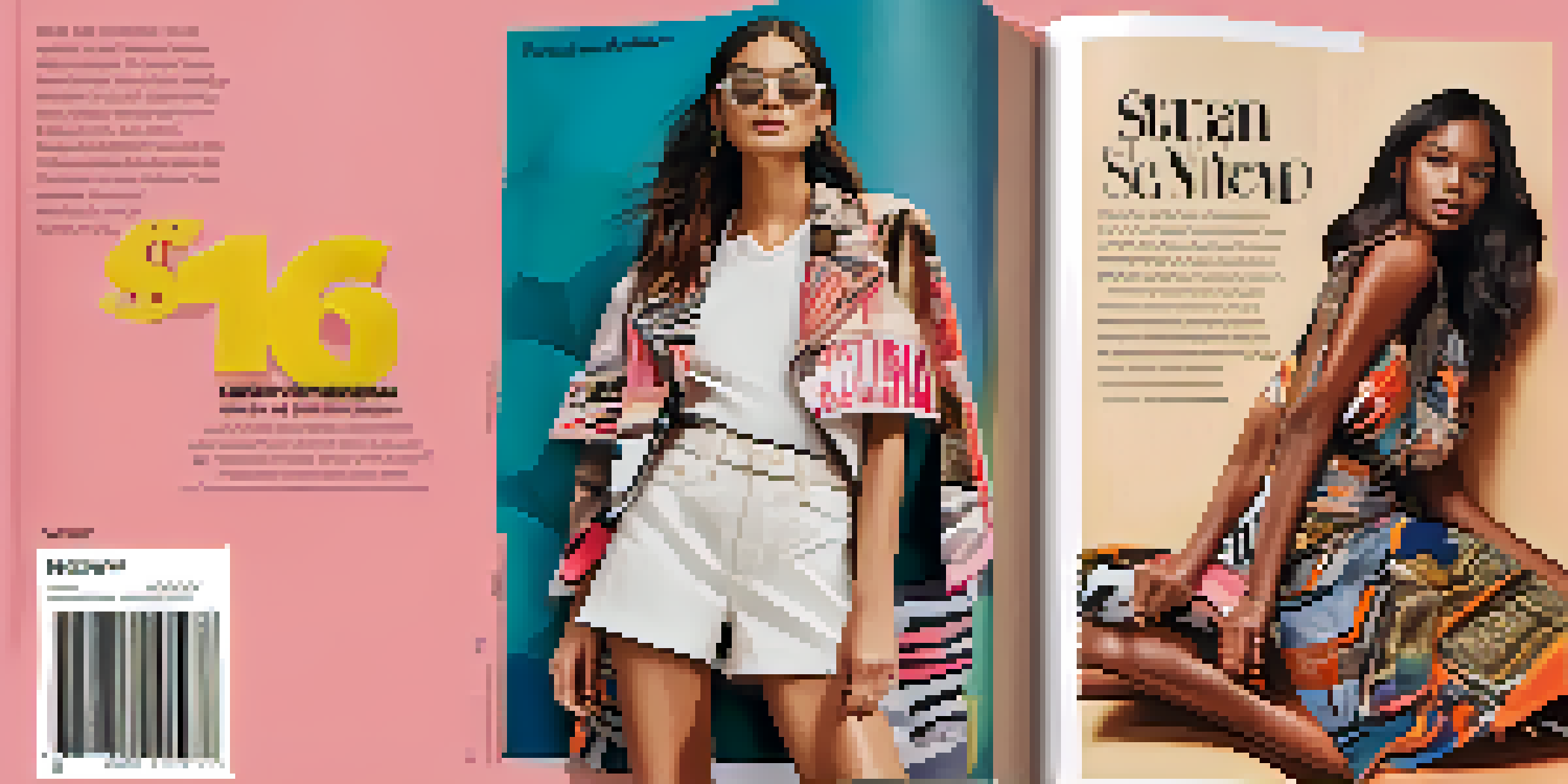Fashion Magazines as Gatekeepers of Style and Trends

The Role of Fashion Magazines in Defining Style
Fashion magazines have long been considered the trendsetters in the industry. By showcasing the latest collections and styles from top designers, they not only highlight what’s in vogue but also dictate what readers should aspire to wear. Essentially, they curate a visual language of style that influences both consumers and designers alike.
Fashion is the armor to survive the reality of everyday life.
The importance of these publications lies in their ability to present fashion as more than just clothing; it’s a form of self-expression. Through editorials, interviews, and features, they encourage readers to interpret trends in ways that resonate personally. This connection transforms clothing from mere fabric into a statement of identity.
Moreover, fashion magazines serve as a bridge between haute couture and everyday fashion. By translating high-end trends into accessible styles, they invite a broader audience to engage with fashion, making it relevant to all walks of life. This democratization of style is crucial in a world where fashion can often feel exclusive.
Spotlighting Emerging Designers and Trends
Fashion magazines play a pivotal role in discovering and promoting emerging designers. By featuring fresh talent, they not only introduce new perspectives to the industry but also inspire established designers to innovate. This cycle of inspiration is vital for keeping fashion dynamic and exciting.

Consider magazines that dedicate entire sections to up-and-coming designers; these features often become launching pads for the next big names in fashion. Readers are given the opportunity to learn about innovative techniques and fresh aesthetics that might not yet be on their radar. This exposure can be incredibly influential, shaping consumer preferences before trends even take off.
Fashion Magazines as Trendsetters
Fashion magazines curate styles that not only reflect current trends but also inspire personal expression and consumer behavior.
In addition to individual designers, these publications often highlight macro trends that can redefine seasons. By analyzing patterns from runways and street style, they synthesize information into digestible content that offers readers a glimpse into what’s next. This foresight keeps enthusiasts ahead of the curve and fuels the anticipation for upcoming collections.
Creating a Visual Narrative of Culture
Fashion is deeply intertwined with culture, and magazines often reflect this relationship through their content. By showcasing styles that resonate with societal movements, they create a visual narrative that speaks to current events and cultural shifts. This connection serves to elevate fashion beyond aesthetics to a platform for storytelling.
Fashion should be a form of escapism, and not a form of imprisonment.
Take, for instance, how fashion magazines have responded to movements like body positivity or sustainability. By featuring diverse models and eco-friendly brands, they help promote inclusivity and responsibility within the industry. This not only educates readers but also fosters a sense of community around shared values.
Through rich imagery and thoughtful editorials, these publications invite readers to reflect on how fashion interacts with social issues. This interplay enriches the reader's experience, encouraging them to think critically about their own choices and the impact of fashion on the world around them.
The Influence of Social Media on Fashion Coverage
In today’s digital age, social media has transformed the landscape of fashion magazines. Platforms like Instagram and TikTok have become essential for reaching audiences, often dictating trends faster than traditional print can keep up. This shift has led to a more immediate and interactive relationship between magazines and their readers.
Many fashion publications have adapted by enhancing their online presence, creating engaging content that resonates with a younger audience. The use of influencers and real-time updates allows magazines to remain relevant, generating buzz around launches and trends almost instantaneously. This immediacy can significantly amplify a new trend's visibility.
Spotlighting Emerging Talent
These publications serve as platforms for new designers, introducing innovative ideas and shaping future trends in the fashion industry.
However, this new dynamic also poses challenges. With so many voices and opinions online, distinguishing authentic trends from fleeting fads can be difficult for consumers. Fashion magazines thus find themselves in a crucial position, acting as trusted guides in the overwhelming sea of information available on social platforms.
Fashion Magazines and Consumer Behavior
Fashion magazines have a profound impact on consumer behavior, often shaping what we buy and how we perceive style. The aspirational nature of these publications can create desires that drive purchasing decisions. When readers see their favorite celebrities adorned in specific brands, it can ignite a rush to emulate that look.
Additionally, the way magazines curate content influences how trends are marketed. By highlighting certain pieces or styles, they can elevate a brand's status or even introduce niche products to mainstream audiences. This curation process is crucial in shaping consumer perceptions and preferences.
Moreover, the rise of digital shopping has further intertwined fashion magazines with consumer behavior. With the inclusion of shoppable links and online exclusives, readers can transition from inspiration to purchase seamlessly. This evolution not only enhances the reader experience but also reinforces the magazine's role as a vital player in the fashion ecosystem.
The Evolution of Print in the Digital Age
As digital media surges, the print format of fashion magazines has had to evolve. While some publications have ceased print editions altogether, others have embraced a hybrid approach to reach their audience. This evolution reflects a broader trend in media consumption, where readers seek instant gratification and convenience.
However, print remains a powerful medium for fashion storytelling. The tactile experience of flipping through glossy pages and the artistry of layouts create a unique connection that digital screens often lack. For many, the physical magazine is still a cherished object that holds emotional value.
The Impact of Digital Transformation
Social media has reshaped how fashion magazines connect with audiences, making real-time engagement essential while also presenting challenges in distinguishing genuine trends.
This coexistence of print and digital demonstrates the adaptability of fashion magazines. By offering exclusive content, collaborations, and visually stunning editorials, they continue to capture the imagination of readers, proving that even in a digital world, there’s still a place for the printed page.
The Future of Fashion Magazines
Looking ahead, the future of fashion magazines seems both exciting and uncertain. As technology continues to evolve, so will the ways in which these publications engage with their audience. Innovations like augmented reality and interactive features could redefine the reading experience, making it more immersive and engaging.
Additionally, the growing emphasis on sustainability in fashion will likely shape editorial choices and brand partnerships. Readers are increasingly conscientious about their consumption habits, and magazines that reflect these values will resonate more deeply with their audience. This shift represents an opportunity for publications to lead by example.

Ultimately, the core mission of fashion magazines remains unchanged: to inspire and inform. Whether through print or digital platforms, their role as gatekeepers of style will persist, adapting to the changing landscape while continuing to celebrate the art of fashion.